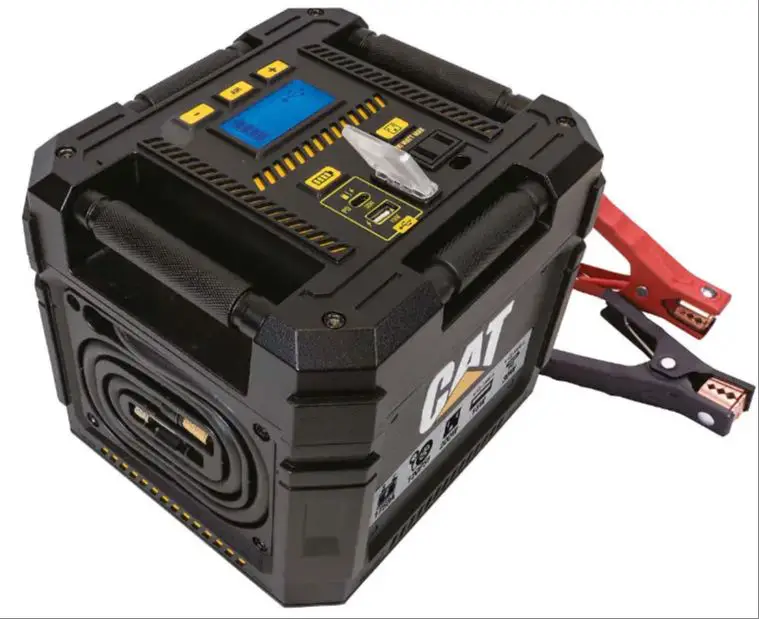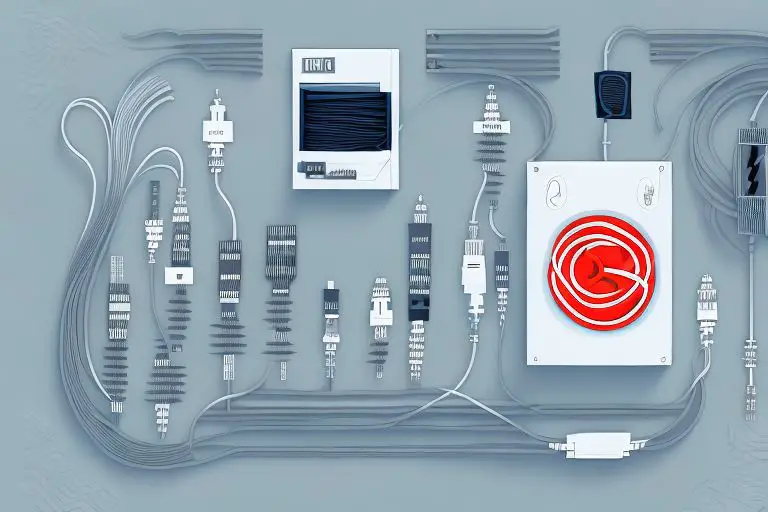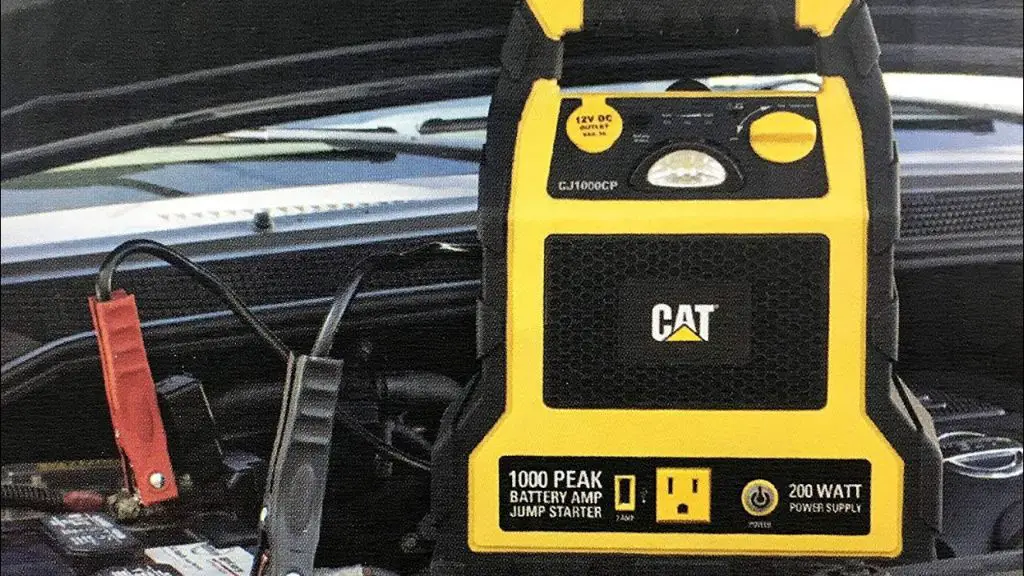A cat jump starter is a portable device that can be used to jump start a vehicle with a dead battery by providing an external power source to start the engine (Jump-start Definition & Meaning). It contains a battery pack and jumper cables that can temporarily connect to a vehicle’s battery terminals to provide enough power to start the engine.
Having a cat jump starter is beneficial as it allows you to start your vehicle immediately in the event of a dead battery, without having to wait for roadside assistance or someone else with jumper cables. This can save you time and avoid the hassle and potential safety risks of being stranded with a dead battery.
Using a cat jump starter simply involves first charging up the jump starter battery, then connecting the jumper cables properly between the jump starter and your vehicle’s battery by clamping onto the positive and negative terminals. Once connected, you turn on the jump starter device which will then provide power to start your engine. It’s important to follow all safety precautions and manufacturer’s instructions.
Safety Precautions
When using a portable cat jump starter, it’s important to take proper safety precautions. Here are some tips:

Charge it regularly to ensure it is ready when needed. Lithium-ion batteries can lose their charge over time if not used. Check the battery level and recharge the jump starter every 1-2 months to keep it powered up. Letting the battery discharge too low can damage it.
Do not expose to extreme temperatures. Store the jump starter in a temperate area, avoiding very hot or very cold conditions. High heat can degrade the battery faster, while freezing temperatures may prevent it from charging properly. Keep it somewhere with a temperature between 50-80°F.
Keep away from water. Portable jump starters are not waterproof. Getting them wet can cause electric shocks or short circuit the device. Store in a dry area and avoid using in rain or snow.
Choosing a Jump Starter
When choosing a jump starter, there are a few key factors to consider:
Size – Consider the physical size and weight of the jump starter. More compact and lightweight models are easier to store in your vehicle and transport. However, larger units often have more power and capacity.
Power – Check the peak amps and battery capacity. You’ll want a jump starter strong enough to start your vehicle’s engine size. Generally, you’ll need 200-300 amps for small 4-cylinder engines and 500+ amps for 6-8 cylinder vehicles or diesel engines (Source 1).

Features – Look for jump starters with built-in LED lights, power outlets, and displays showing remaining charge. Safety features like spark proof connections, reverse polarity alarms, and overcharge protection are also recommended.
Reviews – Research professional tests and customer reviews of different jump starter models online. Sites like Car and Driver and Motor1 provide helpful comparisons and recommendations for top rated products (Source 2).
Consider the above factors and your specific needs to choose the right jump starter for your vehicle within your budget.
Charging the Jump Starter
Before using a jump starter for the first time, make sure to fully charge the internal battery using the included charger and cable according to the manufacturer’s instructions. Charging can take 2-4 hours for most portable jump starters (1). Follow the guidelines in the owner’s manual, as charging methods may vary depending on the model. Plug the jump starter’s charging cable into the DC in port and connect the other end to the wall charger. Insert the wall charger into a 120V AC outlet while charging. Some models may also allow charging the jump starter by plugging the cable into the 12V DC cigarette lighter port in your vehicle. Once fully charged, the jump starter will be ready for portable emergency use.
Connecting the Jump Starter
Properly connecting the jumper cables between the dead battery and the jump starter battery is crucial to safely jump starting the vehicle. Here are the steps to follow:
1. Identify the positive and negative terminals on the dead car battery. The positive terminal will typically have a “+” sign or be red in color. The negative terminal will have a “-” sign or be black in color.
2. Take the red jumper cable and connect one end to the positive terminal on the dead battery. Ensure a secure connection.
3. Take the other end of the red jumper cable and connect it to the positive terminal on the jump starter battery. Double check that the positive clamp is securely attached.
4. Now take the black jumper cable and connect it to the negative terminal of the jump starter battery.
5. Connect the other end of the black jumper cable to a grounded, unpainted metal surface on the disabled vehicle’s engine away from the battery. Do not connect it directly to the negative battery terminal, which can cause sparks.
It’s very important to connect red to red/positive and black to a grounded metal surface. Reverse connecting jumper cables can severely damage the electrical systems (source). Take your time and double check the connections before moving to the next step of jump starting the vehicle.
Jump Starting the Vehicle

Once the jump starter is fully charged, you are ready to use it to start your vehicle. Be sure to follow these steps:
- Turn off the vehicle that needs the jump start. Make sure all electronics like lights, radio, etc. are turned off as well.
- Identify the positive and negative terminals on both the dead battery and the jump starter. The positive terminal is typically labeled with a “+” or “POS” and is red. The negative terminal is typically labeled with a “-” or “NEG” and is black.
- First, connect the red positive (+) cable from the jump starter to the positive (+) terminal of the dead battery. Make sure the connection is secure.
- Next, connect the black negative (-) cable from the jump starter to a metal ground on the vehicle, like an unpainted bolt or the engine block. Do not connect it directly to the negative terminal of the dead battery, as this can cause sparks.
- Turn the jump starter on per the manufacturer’s instructions. You may hear it start charging the battery.
- Try starting the vehicle, avoiding extended cranking. If it doesn’t start after 10 seconds, wait a few minutes before trying again.
- Once the vehicle is running, disconnect the jump starter cables in reverse order – negative cable first, then positive cable. Be careful not to let the cable clamps touch each other or any metal surfaces as you disconnect them.
- Let the jumped vehicle run for 10-15 minutes to allow the battery to recharge before turning off the engine again.
Following these proper connection steps helps ensure safe and effective jump starting. Avoid shorting out the batteries or creating sparks that could ignite hydrogen gas from the battery. If the jump start fails, recharge the jump starter and try again. If problems persist, the vehicle’s battery may need professional testing and potential replacement.
Maintenance
Proper maintenance is important to ensure your portable jump starter continues working when you need it. Here are some tips:
Store the jump starter properly when not in use. Keep it in a cool, dry place out of direct sunlight. Extreme temperatures can damage the internal battery over time. Refer to the user manual for recommended storage temperature range.1
Recharge the jump starter every 30-90 days to keep the internal battery topped up. Follow the manufacturer’s recommendations for recharging frequency. Allow several hours for a full recharge. Some units have indicators to show charge level.2
Inspect the jumper cables and clamps periodically. Replace any cables that are cracked or damaged. Corroded clamps will not make proper contact, so replace them if needed.
Safety Features
When using a jump starter, it’s important that the device has adequate safety features to prevent accidents and damage. Some key safety features to look for include:
Overload protection – This prevents too much current flowing from the jump starter, which could damage the device or the car’s electrical system. Quality jump starters have automatic shutdown if overload is detected (https://www.safetykitsplus.com/blogs/safety/how-to-quickly-safely-use-a-power-bank-jump-starter-to-jump-a-car).
Reverse polarity alarm – Reversing the positive and negative clamps could severely damage the vehicle’s electrical system. A reverse polarity alarm will alert you if the clamps are connected incorrectly before energy is transferred (https://genstattu.com/blog/what-jump-start-car-battery-safety-features).
LED flashlight – Jump starting a car often happens at night or in low light conditions. An integrated LED flashlight makes it easier to see the battery and connectors in the dark (https://fanttik.com/blogs/products-guides/are-lithium-ion-car-jump-starters-safe).
Other safety features like spark-proof connections, integrated fuses, and sturdy cables also minimize the risk of accidents. Choosing a jump starter with multiple safety mechanisms gives an added layer of protection.
Troubleshooting
If your vehicle won’t start after connecting the jump starter, first check that the clamps are making a solid connection to the battery terminals. Loose or corroded connections can prevent current from properly flowing to the battery. Tighten the clamps and scrape away any corrosion on the battery terminals to ensure a clean surface for contact.
Also check that the jump starter itself is adequately charged. Most units have a built-in indicator that shows the charge level. If the jump starter is running low on power, attach it to a wall outlet or car charger and give it time to recharge fully before trying again.
Consult your owner’s manual or the manufacturer’s website for troubleshooting tips specific to your model of jump starter. Many common issues are covered, along with solutions like resetting error codes, testing fuses, or calibrating sensors. The manual can help diagnose problems and walk you through the corrective steps.
As a last resort, contact the jump starter company’s customer support line for assistance. Provide them with your model details and a clear explanation of the issue. Their technical experts can often resolve problems quickly over the phone or email.
Additional Uses
Besides jump starting a dead vehicle battery, portable jump starters have other handy uses thanks to their built-in power banks.

You can use a jump starter to charge small electronic devices like smartphones, tablets, laptops, cameras, and portable speakers. Most jump starters have USB ports and 12V DC outlets specifically for powering and charging accessories. Just make sure not to exceed the jump starter’s rated wattage and amperage limits when charging high-draw devices like laptops.
Jump starters can also run small appliances and electronics as long as they fall within the jump starter’s output capabilities. For example, you could power or charge a refrigerator, CPAP machine, radio, lights, inflator pump, and other accessories off your jump starter. This makes them handy for power outages, outdoor activities, and emergency preparedness kits.
When using a jump starter as a portable power bank, be mindful of how much charge is left in the jump starter battery so you don’t end up draining it. Fully recharge the jump starter after each use.

